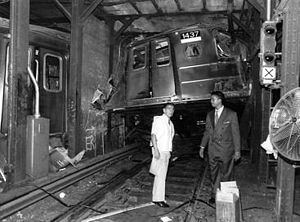Time 12:12 a.m. Passengers 216 Total number of deaths 5 Passenger count 216 | Date 28 August 1991 Trains 1 | |
 | ||
Location North of 14th Street–Union Square Cause Intoxication, driver error, overspeeding Operator | ||
Shortly after midnight on August 28, 1991, a New York City Subway train on the IRT Lexington Avenue Line derailed as it was about to enter 14th Street–Union Square. Five people were killed. It was the worst accident on the subway system since the 1928 Times Square derailment. The motorman was found at fault for intoxication and excessive speed, and served time in prison for manslaughter.
Contents
Accident
During the night of August 27–28, 1991, there was construction on the IRT Lexington Avenue Line that required southbound express trains to switch to the local track. This required the trains to slow down to 10 miles per hour (16 km/h) before entering a "pocket track" between the southbound local and express tracks, so that they would not delay local and express trains that were not going through the switch. At about 12:12 a.m. on August 28, 1991, a ten-car 4 Lexington Avenue Express train, heading southbound with approximately 216 passengers, derailed at the pocket track as it was about to enter 14th Street–Union Square. The train was traveling at as much as 50 miles per hour (80 km/h), too fast for the line's train stops to stop it in time.
Five people died, all almost immediately. Several support columns were destroyed, causing the street above to immediately subside by 0.5 inches (1.3 cm). It was the deadliest subway accident to happen in New York City since the Times Square disaster of 1928.
The first car, #1440, which struck a steel pillar, was cut in half and had its roof sheared off, but its motorman's cab was not damaged. The second, #1439, was folded in half by the barrier between the express and local tracks. Car #1437 was split in half and folded around a support beam, and cars #1436 and #1435 were also seriously damaged. The cars lay tangled between the support beams. The train was damaged so badly that one emergency responder said that he "couldn't even tell where one car ended and another began at some points".
Rescue, investigation, and trial
The accident occurred within earshot of the Transit Police command post in the Union Square station, and within the sight of two Transit Police officers waiting on the platform, and response was rapid. The accident location was very close to the platform, which was used for triage, and field treatment took place on the upper level of the station. Working conditions at the site were very cramped and hot, and it took until 3:15 or 3:45 to extract the last passenger. In total, 121 passengers and 24 emergency responders were taken to hospitals; 16 passengers were injured seriously enough to be admitted. Debris was found as far away as 150 feet (46 m) from the lead car.
The motorman, Robert E. Ray, later said that he had drunk heavily the day before his work shift because he was depressed that his ex-girlfriend would not let him see their two children, and that at the time of the accident he had fallen asleep. He was not hurt in the crash, so he walked into the station and identified himself, then sat on a park bench during the rescue operation. The NYPD later reported that he drank three beers after the accident. He was arrested at 5:30 while returning to his apartment building, and when tested approximately 13 hours after the accident, his blood alcohol level was 0.21; the legal level in New York State was 0.10 at the time.
At his trial it was established that Ray had overshot the platforms at several stations in the Bronx and had not braked approaching 14th Street–Union Square, and that both the conductor and an off-duty NYCTA employee had advised him to reduce the train's speed.
On October 15, 1992, a jury acquitted him of murder but found him guilty of five counts of second-degree manslaughter, and on November 6 he was sentenced to five to fifteen years in prison plus terms of between one and seven years for assault on 26 of the injured passengers, all to run concurrently. He was released in April 2002.
Aftermath
Service on the Lexington Avenue Line resumed six days after the accident, on September 3, after completion of the site investigation and four days of round-the-clock debris removal and construction work, including the Labor Day holiday. The five R62 subway cars destroyed in the accident—the lead car, #1440, and four of the five following cars, #1435, #1436, #1437, and #1439—were scrapped. In addition to the support columns, two sets of track, a third rail, two signal sets, two switches, and an air compressor room had been destroyed. The switches and tracks were rebuilt, with the NYCTA removing the "pocket track" on which the train had derailed and replacing it with a simple diamond crossover.
Reporters at New York Newsday won the 1992 Pulitzer Prize for Spot News Reporting for their coverage of the accident.
A 1992 study commissioned after the accident by the New York City Transit Authority found that some signals in the subway system, including several on the Lexington Avenue line, were spaced too closely for a train traveling at maximum speed to have time to stop, confirming the finding of safety investigators immediately after the crash; the issue resurfaced after a rear-end collision on the Williamsburg Bridge in 1995. Ultimately, the accident led to the phasing-in of communications-based train control and automated trains on the New York City Subway in the 21st century.
